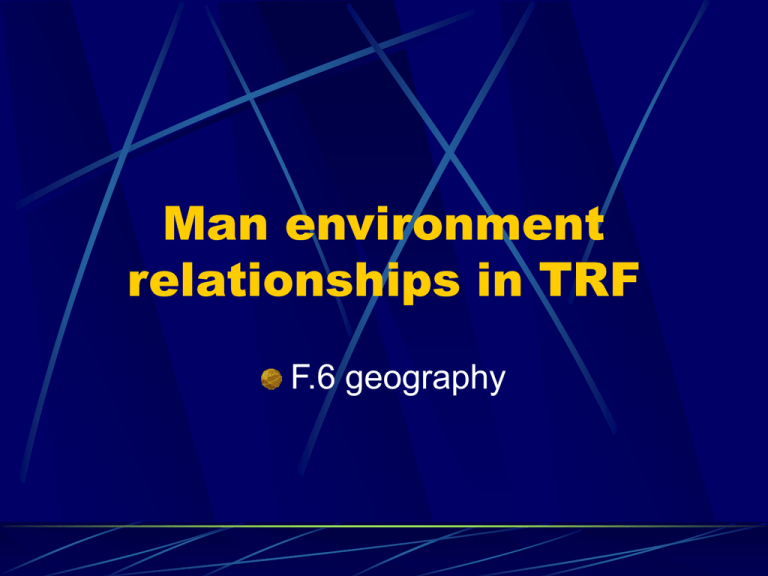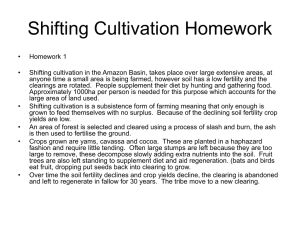Document
advertisement

Man environment relationships in TRF F.6 geography The impact of the environment on man The Amazon Basin Slash and burn or shifting cultivation is most common The soil will rapidly depleted after one to two crops, the cultivators are forced to leave the clearing site and move to a new one The process Selecting the site Clearing the forest Burning off the dead vegetation Planting crops Weeding and harvesting the crop migration Selecting the site Clearing is easy in primary forest cause little undergrowth The secondary forest also dries out more easily A steep hillside is usually choose because there is updraught to spread the fire Clearing the forest Take place at dry seasons It is done by simple hand tools Such method may protect the virgin forest The tallest trees cut down first , it will drag down shorter tree on the path Burning off the dead vegetation The ashes will enrich the soil Heavy clay soil dried out ,developing large cracks in which ash accumulates People use only small digging sticks and hands hoe (鋤頭)for ploughing The debris after burning off helps to reduce runoff and reduce erosion Planting crops Multi-storey agriculture are easily found Yams are the ground crops Millet are lower storey Manioc beans or maize the third storey Bananas, breadfruit ,other tree crops ,the upper storey Advantages of mixed cropping Reduce the amount of space to cleared Lengthen the seasons of growth Enables maximum return for the minimum effort Provides more complete cover,shading the ground and prevent the growth of weeds Different crops allow the best use to be made of soil, sunshine and rainfall Provides insurance against the failure of any one type of crops Ensure a more constant supply Seeds are sown by mouth (spitting) or by using a primitive seed drill ( 種子鑽 子) (a hollow stick which enables seed to be dropped into the holes without having bend over ) The main crops are maize, pulses, green vegetables, yams and manioc (cassava) Crop rotation helps to prevent soil exhaustion and erosion Weeding and harvesting The swidden receives little attention during the growing period Root crops can be left in the ground and dug up as required – one root crop providing enough food for a family for several days Vegetables are hand-picked. When ready, cereals are dried, threshed (打穀) and husked (去穀類外皮 ) Migration Tropical soil depleted easily (1 to 3 yrs) Weed and undergrowth will invade easily at that time when the nutrient loss Farming will leave the clearing and look for a fresh site This allows the forest to reclaim the clearing and rebuild soil fertility. This is called bush fallowing Natural hazard also cause migration : disease like malaria and sleeping sickness, disasters such as insect plagues and droughts and animal invasion The land can be reused after a 8-20 year of bush fallowing when soil fertility has been restored The village and way of life Location : usually near the stream ,for food, transport, domestic use Plan : 20 to 300 people ,in a single street or circular group Typically village house : village house (long house)are elevated because avoid wet climate, termites, tigers and panthers (黑豹)cannot invade the house Way of life Use primitive tools Fishing , hunting ,farming , weeding , harvesting, gathering Plantation : cacao, cotton and rubber Difficulties in timber production The wet and hot climate prevent people development of the TRF Species are mixed, no pure stand ,making cutting difficult Hardwoods have thick trunks and buttress root and are difficult to fell Transport difficult Swampy ground Insects ,disease Lianas ,climbers make movement in forest diffcult The impact of man on environment The ecological impact of shifting cultivation : - the direct burning of the organic matter can speed up the oxidation of the organic matter and humus in the top soil - the primitive method can reduce structural damage to the soil. No chemical are used and thus no environmental hazards result In some area, weeding is done manually and selectively to preserve trees seeding and spalings , adding forest regeneration No draught animals are used ,so the return in relation to input is very efficient Shifting Cultivation add variety to their food by hunting, fishing,gathering The full vegetative cover can reduced erosion ,while multiple cropping reduce pest and disease hazard Abandoning the clearings Abandoning can cause soil erosion , structural damage and fertility decline together with weed invasion and disease Long fallow period is need if want to resume fertility Managed rotation of fields is better using the corridor system (走廊式輪植法) If shifting cultivation is subsistence purpose ,it pose lesser harm to the environment Deforestation It generate many problems : Displacement of the rainforest Changes in the hydrology of the Amazon Basin accelerate surface runoff ,reducing infiltration , modify the fluvial regime Variation in run-off ,sediment load . Sedimentation are prevailed It will affect aquatic plans and animal Deforestation may produce climate changes such as change in soil temperature, humidity, wind speed and insolation Biomass reduction – it leads to soil erosion ,nutrient loss Cattle ranching The removal of TRF for cattle ranching free nutrients from the biomass producing a reduction in nutrients The pasture deterioration can lower the carrying capacity of land from 200 cattle /km² to 50-80 cattle /km² Overgrazing, trampling and soil compaction also lead to accelerated erosion or poor drainage Effects on aquatic resources Reduce the supply of organic debris which is an important food supply for fish It can alter run-off and erosion ,affecting the productivity of the streams by altering the water quality Increasing population Increase pressure upon food producing land and reduce the period of essential bush fallow Old clearing are reused sometimes, forest replaced by woodland or open grassland Introduction of European agricultural technique Geometrically arranged fields have reduced the protective ground cover, accelerating soil depletion through leaching The introduction of deep ploughing and steel ploughs also increased erosion because they allow plots to be completely cleared ,exposing soil for erosion Cash cropping brought changes in the life of the tribes (it brings personal gain and the possession of the land ) Other effect : - Mining leaves behind mining pits full of water , it favour the development of malaria Land development solution An economically productive and ecologically stable system is need One of the method is compartmentalizing (分隔) the landscape ,then apply separate management strategies to each unit Use of the varzea Varzea is a place which have higher potential land Intensive agricultural and use of aquatic resources can be practised here But it should be controlled with a fixed fishing season and limited on the fish caught The terra firma To protect the terra firma(upland savanna and forest ), there would be low intensity,shifting cultivation and plantations of selected tree and shrub crops Large scale forest clearance for farming and ranching in these area would be stopped Agricultural alternatives Agricultural/ silviculture ( 農耕做林學) is a possible alternative The inter-planting of annual food crop, perennial food crops and slow-growing timber species This system is a compromise between crop production and land protection Population control This can be used to prevent too much pressure on the land Educational programmes to encourage some form of family planning are necessary Native participation Cash cropping can allow specialization and capital formation in these underdeveloped areas The tribes can use these profit to buy fertilizers ,tools and transport. Thus, improving the living standard





